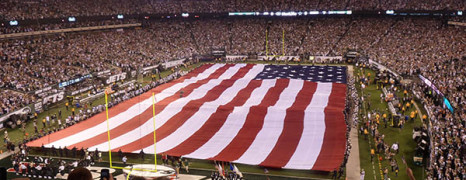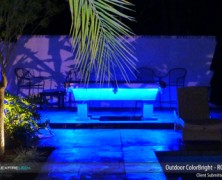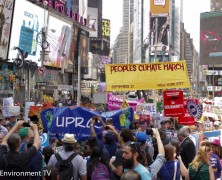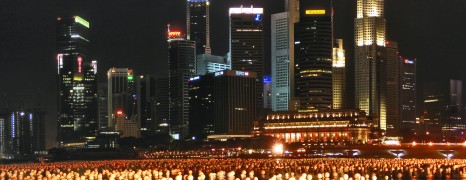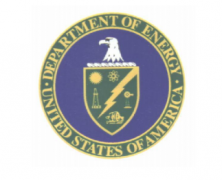When the Seattle Seahawks face off against the New England Partiots at this upcoming Super Bowl, LED stadium lighting will illuminate the field. Scheduled for Feb. 1st, the game will be the first NFL championship match that has ever been lit with LED lights. The LED lights were installed last fall at University of Phoenix Stadium. The Arizona Cardinals and San Francisco 49ers were the first to play a game on Sept. 21st, 2014 under the new lighting system. The LED stadium lighting will significantly increase the light on the field and will produce a more vivid picture on the screen for the 110 million plus expected viewers of this year’s game. The light will shine in a more uniform manner than the legacy system, creating less shadows and a clearer view of the action taking place on the field. Another advantage of LED lighting is the fact that they don’t flicker, which will lead to less distractions during slow-motion replays. There will be 312 LED fixtures installed to replace the 780 metal halide lights. The new LED stadium lighting will use just 380,000 watts compared to the 1.24 million watts needed to power the old system. Combined with savings generated for lower air-conditioning costs, most venues that choose LED stadium lighting enjoy a 75% reduction in overall energy consumption. Further, the system will age more gracefully than metal halide lights, which take on a reddish hue and lose brightness over the years. The University of Phoenix Stadium was originally opened in 2006. With its innovative design that includes a retractable roof and field, it’s recognized as one of the most advanced stadiums in North America in terms of its engineering. This multi-purpose facility previously hosted Super Bowl XLII in 2008. It also hosts the annual Fiesta Bowl, and numerous international soccer matches. The stadium seats 63,400 fans, but is expandable to seat 72,200. Questions? This Super Bowl Sunday will be lit by LEDs? Just another reason that Flexfire LEDs is excited about being a part of the future of LED lighting! If you have any questions about LEDs, and specifically LED strip lighting, remotes, and dimmers, please stop by our website at flexfireleds.com or give us a call at 1-844-FLEXFIRE (1-844-353-9347) to talk with one of our design specialists...
5 Different Ways To Use Color Changing Led Strip Lights...
posted by Flexfire LEDs
Flexfire LEDs ColorBright RGB Color-Changing Strips are popular for both home and commercial applications. In this post, we present you with five ideas for using color changing LED strip lights. Waterside Color Changing LED strip lighting Who doesn’t like spending time by the pool or the lake during warm summer nights? Color changing LED strips are great for this purpose because the changing colors will boost the mood of your gathering, be it among friends or family. Make sure that the lights are rated for outdoor use and that they are water resistant. Flexfire LEDs offers two choices for outdoor-rated color changing LED strips: ColorBright RGB 150 Outdoor strips and ColorBright RGB 300 Outdoor strips. The 300 RGB have double the amount of LED diodes per reel and produce twice as much light as the 150 RGBs. Living Room Color-Changing LED strip lighting Color changing LEDs in the living room are a great way to start a party, or set the mood on a date. Or to help you find your “happy place” after a stressful day at work. Did you know that light color has a significant effect on on our moods? That means putting color changing lights in the living room will give you greater control not only of your lighting environment, but also of your mental state. While many people come to us in their search for colorful lights, they would like a “white light” option as well. For these clients we suggest our ColorBright RGB plus Warm White strips. Using a remote, users switch between warm white setting and the RGB color-changing setting. The result of this amazing pairing is beautiful and allows for an unparalleled degree of personal customization. Stage Color-Changing LED strip lighting Most people write off strip lights for stage lighting purposes because...
How LED Lights Are Helping Address Climate Change...
posted by Flexfire LEDs
In New York City, 300,000 to 400,000 people recently took to the streets calling for action on climate change. These concerned world citizens would be pleased to note that as we shift away from inefficient incandescent bulbs, those who choose LED lights are helping address climate change by minimizing humanity’s environmental impact. Electricity production is the single largest contributor to CO2 emissions, accounting for 38% of U.S. emissions from 1990-2012. LEDs help us address climate change by lowering our electricity demand and therefore lowering our CO2 emissions. While installing LED strip lights in your kitchen won’t stop global warming, if you choose to make the investment in LEDs, you’re doing your part to slow its progress. Here are the top environmental reasons for choosing LEDs over other conventional lighting sources: Energy Efficiency High quality LED lights work at 80% efficiency. That means that 80% of the electricity used by an LED chip goes straight into producing light. Compare that to an incandescent bulb, which in many cases is just 20% efficient — 80% of the electricity used is transferred into heat instead of light. The U.S. Energy Information Administration estimates that in 2012, lighting constituted 17% of the total energy used by homes and businesses in the United States. Switching our lights over to LEDs, making them use electricity with 80% more efficiency, would have a dramatic impact on our CO2 emissions. There are other cases where LEDs will come in handy as well, such as LED refrigerator display lighting and poultry farming, where we can further lower energy demands since cool LED running temperatures require less artificial cooling. Furthermore, LEDs produce directional light, meaning light isn’t wasted in directions where it isn’t needed. Less Waste The typical lifespan of an incandescent bulb is 750 to 1,000 hours. CFLs,...
The Future Of LED Lighting: A Brave New World
posted by Flexfire LEDs
What’s the biggest difference between LEDs and other forms of lighting systems? Is it that they’re 85% more efficient than incandescent bulbs? Or that they last thousands of hours longer than CFLs? While there are obvious benefits, according to Fast Company, the most revolutionary component of LEDs is likely to be their ability to recognize digital signals. For the first time, our lighting systems are going from analog to digital. No longer do lights just turn “off” or “on.” Now they can be “tuned” to emit any color of the rainbow, or change temperature and brightness, all from the touch of a finger on your smartphone app. We’re now staring at the future of LED lighting, and it’s a beautiful, brave new world. Since 2007, the U.S. has been effectively phasing out inefficient incandescent lighting through federal regulations enacted in the Energy Independence and Security Act. After starting out with an effective ban on 100-watt incandescent bulbs in 2012, followed by 75-watt bulbs in 2013 and 60- and 40-watt in 2014, LEDs have been the industry favorite as a replacement for Edison’s monumental invention over a century ago. One of the first reasons that LEDs took off instead of efficient but sterile CFLs is that they contain solid-state lighting (SSL) semiconductors. It was just twenty years ago Nichia’s Shuji Nakamura invented the blue LED in Japan. By covering the blue light in phosphorous coating, the industry was soon able to introduce a white LED light onto the market. While the first generation of LED lighting failed to outperform traditional lighting sources in performance and pricing, the predictable improvement curve of SSL has led prices to fall dramatically as product research and investment has skyrocketed. By 2013, Cree had released a LED bulb that looked and felt like a 60-watt incandescent, priced at under $14. By 2014, the LED lighting market is estimated at $17.4 billion and is predicted for rapid growth through 2020. The current rise can be explained mostly by LED technology’s superior durability, efficiency and performance in comparison to other lighting technologies. Further, the emergence of home automation and the “Internet of Things” will only serve to catapult LEDs to deeper and deeper market penetration rates. Here are benefits that digital networks and intelligent home automation systems hold for the future of LED lighting and human well-being. Health Benefits: “You have to start thinking of light as a drug,” said Terry K. McGowan, the director of engineering for the American Lighting Association, in an interview with nytimes.com. That means that we have to start recognizing the impact lighting has on our mental and emotional states. As artists have known for a long time, color affects our moods and can elicit emotional and physiological responses. For example, blue wavelengths in light — which LEDs are rich in due to their reliance on blue lights — have been shown to help us stay awake. Furthermore, LED lights can be programmed to follow the natural light rhythms of sunlight. This will increase human well-being by maximizing the efficiency of our circadian rhythms to indoor lighting, increasing focus, energy and fighting insomnia and depression disorders. Installed at work, automated LEDs will be able to increase worker productivity. Installed in the bedroom, automated LEDs will be able to help us fall asleep and wake up on time. Not only that, but LEDs are an amazing tool for indoor gardening, which help people, even those living in poor growing climates, to produce their own organic food and plants. Energy Efficiency Benefits: LEDs are already 80% more efficient that incandescents and a good 20% to 30% more efficient than most CFL options. But the efficiency of the technology doesn’t end at the individual diode. LEDs are much better than CFLs for home automation systems due to the advanced control options and rapid response switching and dimming. Using home automation systems, LED lights can be programmed to turn off or dim down...
$4 Billion DOE Loan Program Includes LED Lighting Projects...
posted by Flexfire LEDs
The U.S. Department of Energy (DOE) has announced a $4 billion loan guarantee program to lower greenhouse gas emissions in the United States. LED lighting projects will qualify for the program. To qualify for the loans, projects must meet one of the following requirements: renewable energy systems; efficient electrical generation, transmission and distribution technologies; or efficient end-use energy technology (LEDs qualify as an efficient end-use energy technology). Applicants should have a project that is market-ready, replicable and would not likely be fully financed on a long-term basis by commercial banks. The DOE loan program is primarily geared toward renewables. LEDs are increasingly being incorporated with renewable technologies such as solar energy, and are helping to make renewable technologies more viable. The efficiency and reduced costs of solar-powered LEDs means they have already started to outperform electrical grid wiring in applications such as road and bus shelter lighting all the way from Boston to Abu Dhabi. The primary opportunity for LED lighting in this federal loan guarantee program lies in its compliance with the efficient end-use category. LEDs use 80% less energy than standard incandescent lighting. Not only that, but the advanced programing capabilities and rapid “on/off” switching of LEDs lend themselves to home automation projects and use in intelligent lighting projects aimed to reduce energy usage. LEDs are more efficient than other light sources because the vast majority of energy they use is transferred into light rather than heat. With an estimated 17% of the total energy used in commercial and residential sectors in 2012 going to lighting, the potential for LED energy savings across the nation is enormous. Initial applications for the federal guaranteed loan programs are due October 1, 2014, along with a $50,000 fee for the first phase of the DOE loan guarantee...






